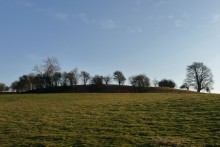|
|
|
|
Slwch TumpHillfort
|
||||||||||||||||||||||||
|
|
|
Images (click to view fullsize) |
|












|
Fieldnotes |
|
|
Visited 16.6.13 This is a site which had been on my ‘hit list’ for a few years so it was nice to finally get to visit. I approached from the south via a public footpath which was squeezed between two houses on an estate called Bryn Glas? – alongside house number 6. Although overgrown the gravelled footpath started off in good condition with handy steps taking you up the steep slope towards the Hillfort. Unfortunately this didn’t last as the gravel / steps soon gave way to a muddy track. It was a pretty walk through the trees but very slippery. The higher up the hill you went the steeper the path became. Waking was quite difficult in the slippery mud. I eventually emerged out of the trees, via a stile, and into an open field. I continued up hill and was soon at the ramparts of the Hillfort. These were quite well defined and stood in places up to 2m high. I walked right around the defences and started a bird of prey who in turn startled me! There are great views to be had overlooking Brecon, its cathedral and in the distance the dominant Pen Y Crug Hillfort. Lucky for me the rain was just about holding off although there were dark menacing clouds approaching from the north. Time to slip and slide back down the path back to the safety of the car before I get soaked! This is a cracking site to visit and I am glad to have finally got here – I wasn’t disappointed. If you are in the Brecon area this well worth the effort and is a lot easier/quicker to visit than Pen Y Craig if you are struggling for time. |
Posted by CARL 18th June 2013ce |
|
SO 057284 An iron age hillfort that is close to the centre of Brecon, Powys. It isn't a sensible idea to try and drive up to it as it is along a mud trackway. The site is pasture, so there shouldn't be a problem with bracken, but if wet the track to it will be muddy. A public footpath circles the site, I met a landowner/worker when I was off the path and he was friendly. From the B4602 it is a 15 minute walk to the site (all uphill). B 4602, just to the north of the hospital is a public footpath on the right. Take it, and when prompted by a sign for a Youth Hostel, follow that until you pass a TV Relay Station on your left. Shortly afterwards you will come to a gate and stile, up and across the field is Slwch Tump. It has a single scarp which the Cadw guide for the region states is between 3 and 4.6 metres high. there is no ditch or counterscrap. It is possible to walk completely around the site on the bank. More recent field boundaries divide the enclosed area of the hillfort. Cadw guide gives the defended area as 242m by 187m. The area inside the bank gently rises, there are signs of quarrying. Field entrances give the impression that it has two entrances, but the Cadw guide believes the original one to be the most northerly one. "...the hill was formerly known as Penginger or Pen Cefn y Gaer, the hilltop ridge with the hillfort". |
Posted by elderford 23rd February 2003ce Edited 1st July 2003ce |
Folklore |
|
Almedha the martyr, twenty-third daughter of Brychan Brecheiniog, unfortunately "suffered martyrdom upon a hill near Brecon, called Pen-ginger. This hill is now generally known by the name of Slwch, though part of it still retains its old appelation. Pen-ginger is a corruption of Pen cefn y Gaer, i.e., the summit of the ridge of the fortification, from an old British camp, the remains of which are still visible.p21-22 of 'The Heroines of Welsh History' by Thomas Jeffery Llewelyn Prichard (1854), now online at Google Books. *eagle eyes will notice this is Lughnasadh or Lammas. This are Giraldus Cambrensis's words, from his Itinerary: There are many churches in Wales distinguished by their names [the names of St Breinioch's children], one of which, situated on the summit of a hill, near Brecheinoc, and not far from the castle of Aberhodni, is called the church of St. Almedda, after the name of the holy virgin, who, refusing there the hand of an earthly spouse, married the Eternal King, and triumphed in a happy martyrdom; to whose honour a solemn feast is annually held in the beginning of August, and attended by a large concourse of people from a considerable distance, when those persons who labour under various diseases, through the merits of the Blessed Virgin, received their wished-for health.Online at the excellent 'Vision of Britain' website. Giraldus wrote this after his tour through Wales in 1188. http://www.visionofbritain.org.uk/text/chap_page.jsp?t_id=Cambrensis_Tour&c_id=4 |
 Posted by Rhiannon
Posted by Rhiannon6th May 2007ce Edited 7th May 2007ce |

